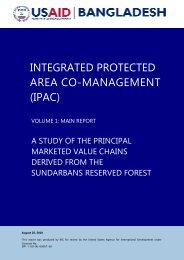Child Equity Atlas - BIDS
Child Equity Atlas - BIDS
Child Equity Atlas - BIDS
Create successful ePaper yourself
Turn your PDF publications into a flip-book with our unique Google optimized e-Paper software.
<strong>Child</strong> Worker and the Sectors of Employment<br />
<strong>Child</strong> Worker and the Sectors of Employment<br />
4.0.0 <strong>Child</strong>ren’s involvement in work adversely<br />
affects their rights to health, education,<br />
protection and participation as well as limits<br />
their opportunity to acquire the knowledge and<br />
skills needed for gainful future employment,<br />
often perpetuating the cycle of poverty. Pursuing<br />
gainful economic activity by children keeps them<br />
out of school and poses a big obstacle in the<br />
achievement of universal primary education goal<br />
(MDG-2) with equity for many countries, including<br />
Bangladesh. Given the huge negative impact of<br />
children’s involvement in work, Bangladesh has<br />
been striving to cope with the high proportions of<br />
working children and those who are out of school.<br />
The commitment to reduce children’s involvement<br />
in work and its socioeconomic consequences<br />
is fully in line with national aspirations and laws<br />
including the United Nations Convention on the<br />
Rights of the <strong>Child</strong> (UNCRC), the International<br />
Labour Organization (ILO) Convention No. 138 on<br />
the minimum age for admission to employment,<br />
1973 and Convention No. 182 on the Worst Forms<br />
of <strong>Child</strong> Labour, 1999 17 .<br />
4.0.1 From statistics by the Bangladesh Bureau<br />
of Statistics (BBS) such as the Report on National<br />
<strong>Child</strong> Labour Survey (2002-2003), the BBS/UNICEF<br />
Multiple Indicator Cluster Survey (2006) and the<br />
ILO Baseline Survey on <strong>Child</strong> Domestic Labour in<br />
Bangladesh (2006) the prevalence of child labor is<br />
high and its consequences are enormous.<br />
4.0.2 In this chapter, the situation of children<br />
(10-14 years) who are out of school and involved<br />
in paid work has been examined nationally<br />
and spatially to pin down the locations where<br />
17<br />
http://www.un.org/en/globalissues/briefingpapers/childlabour/intlconvs.shtml<br />
the practice is most prevalent. As mentioned<br />
before, the term real child worker, in this <strong>Equity</strong><br />
<strong>Atlas</strong> refers to children (10-14 years old) who are<br />
employed for the production of market and nonmarket<br />
goods 18 not for household use or unpaid<br />
household services and who are not in school. Two<br />
specific indicators: the proportion of real child<br />
worker (10-14 years old) and real child worker<br />
(10-14 years old) by sectors (agriculture, industry<br />
and service) have been taken into consideration<br />
in this chapter.<br />
4.1 The Real <strong>Child</strong> Worker<br />
4.1.1 The proportion of real child worker (10-14<br />
years old), who are out of school and employed<br />
in Bangladesh, was at 6 per cent in 2011, a drop<br />
of a little over 4 percentage points in the last<br />
decade when the proportion of child workers was<br />
10.5 per cent (2001).The proportion of workers is<br />
higher among the boys (9.1 per cent) than girls<br />
(2.6 per cent).<br />
4.1.2 By geographic regions, the prevalence of<br />
real child worker is higher in the urban areas (9.0<br />
per cent) than in the rural areas (5.1 per cent).<br />
The prevalence is not uniform throughout the<br />
country, with some geographical areas showing<br />
higher rates than others. By administrative<br />
divisions, Dhaka and Sylhet have higher<br />
proportions of real child worker at 8.0 per cent<br />
and 7.5 per cent respectively while Khulna has<br />
the lowest proportion (3.7 per cent) of children<br />
working (Figure 4.1). As shown in Maps 4.1<br />
and 4.2, significant differences also exist in the<br />
rates between different districts and upazilas.<br />
18<br />
Production of market goods and services involves those<br />
primarily intended for sale, and non-market goods primarily<br />
for own final consumption.<br />
55














